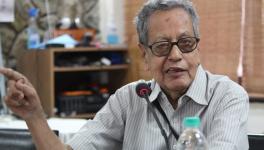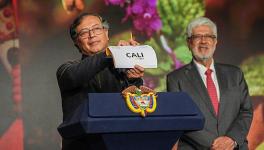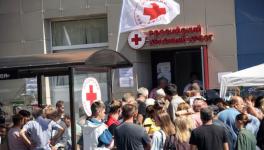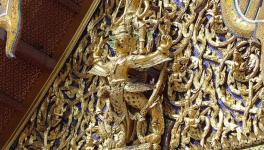After Five Decades of War, Peace in Colombia
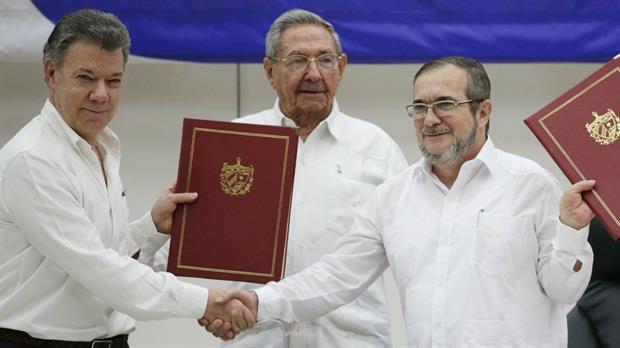
Peace in Colombia
In a historic move, the FARC, the longest running and probably the most powerful guerilla movement in Latin America, has reached an agreement for a ceasefire with the Colombian government of President Juan Manuel Santos. This brings to an end a 50-year civil war in Colombia that has killed over 250,000 people and displaced an estimated 6 million.
“May this be the last day of the war,” said Farc chief Timoleón “Timochenko” Jiménez, his voice choked with tears, shaking hands with Colombian President Juan Manuel Santos at the June 23rd signing ceremony in Havana, Cuba. The two year long peace talks were held under the aegis of the Cuban government. The ceasefire announcement was attended by President Raul Castro, Cuba, President Nicolas Maduro, Venezuela and the UN Secretary General, Ban Ki-moon, who welcomed the deal in the context of a “world set by seemingly intractable war”. President Raul Castro declared that the peace accord was a “victory for the people of Colombia”.
FARC was started in the 60's with a small group of peasant leaders and leftists demanding a better deal for the poor. It arose out of a previous two decades of violence against left and liberal sections in Colombia, backed by assassinations, death squads and military rule. FARC itself was later condemned for using violence against others, kidnapping for ransom, and a tacit alliance with drug trade. But people forget that its history originates in the brutal oppression by the Colombian state of the Colombian peasantry backed by the US. This was the war that the CIA and the infamous School of Americas launched against all those they considered left-wing. A whole generation of army officers and soldiers from Latin America and the Caribbean were trained in the School of Americas, with torture manuals, methods for “pacifying” the countryside and teaching “disappearing” of dissenters.
In 1986, Patriotic Union, a party close to the FARC won local and federal elections and it appeared a peace process could be started with some hope of success. This failed as more than 3,000 of its supporters and leaders were killed by Army's death squads, who opposed any peace with FARC. This also led to a distrust in FARC of peace talks with the Colombian government, fearing that it would be a ruse to disarm, and then later, liquidate them.
Successive Colombian governments have been the most pro-US in Latin America. Colombia was repeatedly used by the US against Venezuela and the ALBA groups of countries in the Organisation of American States (OAS). Álvaro Uribe, the pro US President of Colombia from 2002 to 20010, led brutal campaigns against FARC, and also brought Colombia to the brink of war against Venezuela. He and his brother have been accused being complicit with the para military death squads, active in the countryside against FARC sympathisers. He is bitterly opposed to the peace accord that President Santos has negotiated, and remains wedded to the belief that FARC should be physically liquidated.
The peace accord, signed after a long negotiating process, has still many pitfalls. The FARC side is apprehensive that if they disarm, will it lead to what happened earlier with the Patriotic Union in the late 80's. Both sides have maintained an uneasy de facto ceasefire for some months, leading to the hope that with a formal ceasefire, there would be confidence on both sides to take the next steps.
The 2-year long peace negotiations were conducted under the aegis of the Cuban government, with the Venezuelan government of President Maduro playing an active supporting role.
The peace accord has agreed that apart from armed violence, it will also address the root cause of the five decades old civil war – the problem of rural inequality. Colombia is one of the most unequal countries in the world, figuring in the list of ten countries with the highest Gini index according to World Bank data.
The terms of the agreement include rebel disarmament and demobilization. FARC will hand over its weapons to United Nations monitors within six months. The two parties have agreed to establish 22 transitional demobilization zones. Around these designated areas, a one-kilometre security zone will be established, where members of Colombian security forces will not enter.
FARC will begin a process of demobilization, and be disarmed 180 days after the signing of a final peace deal.
President Santos has now two years of his remaining term to bring this peace process to a conclusion and set a new path for Colombia.
Get the latest reports & analysis with people's perspective on Protests, movements & deep analytical videos, discussions of the current affairs in your Telegram app. Subscribe to NewsClick's Telegram channel & get Real-Time updates on stories, as they get published on our website.









